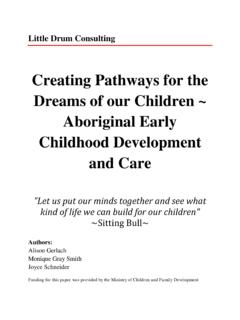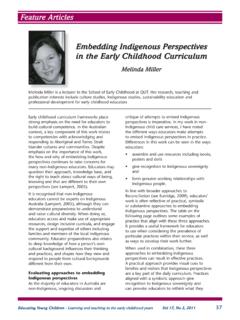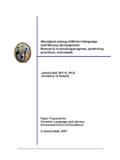Transcription of Environmental Scan Oral Health Services in British ...
1 Environmental scan oral Health Services in British Columbia for First Nations and aboriginal children aged 0 7 years Prepared for the Tripartite Planning Committee for First Nations and aboriginal Maternal and Child Health by Ministry of Health Healthy Women, children and Youth Secretariat First Nations and Inuit Health Branch, Health Canada Regional Health Authorities March 16, 2012. 1|Page Environmental scan oral Health Services for First Nations and aboriginal Families Acknowledgements The following individuals were involved in the preparation of this report.
2 Marilyn Blondahl, Fraser Health Authority Carol Charbonneau, Vancouver Coastal Health Authority Mary Chu, Ministry of Health Amy Gendron, Ministry of Health Carol Gulliford, Interior Health Authority Brenda Isaac, Health Canada, First Nations and Inuit Health Branch, children s oral Health Initiative Carolyn King, Fraser Health Authority Brenda Matsen, Northern Health Authority Esther Pace, Vancouver Island Health Authority Carla Springinotic, Ministry of Health Mary Lou Walker, Health Canada, First Nations and Inuit Health Branch, children s oral Health Initiative Renada Walstrom, Nak azdli Health Centre Dr.
3 Malcolm Williamson, Ministry of Health Joanne Wooldridge, Vancouver Coastal Health Authority Alma Zukanovic, Health Canada First Nations and Inuit Health Branch, Maternal Child Health 2|Page Environmental scan oral Health Services for First Nations and aboriginal Families Table of Contents Introduction .. 4. Background .. 4. 8. Results .. 8. Population Distribution .. 9. Summary of oral Health Services and Providers .. 10. oral Health Services and Providers On-reserve, by Health Authority .. 14. Discussion and 17. Appendix A: Health Canada s First Nations and Inuit Health Branch Early Childhood Development Programs.
4 24. Appendix A2: Public Health Agency of Canada (PHAC) .. 26. Appendix B: Non Insured Health Benefits .. 27. Appendix C: 2011 Early Childhood oral Health Services , Population Estimates*, and Child Development Programs for On-Reserve Communities .. 30. Appendix D: oral Health Care Providers for On-Reserve Communities Detailed Survey 40. Appendix E: Off-Reserve Community Services .. 68. Appendix F: Public Health Agency of Canada, Off-Reserve Early Childhood Development Programs .. 72. 3|Page Environmental scan oral Health Services for First Nations and aboriginal Families Introduction In July 2011, BC Ministry of Health (MOH), the five Regional Health Authorities, and Health Canada s First Nations and Inuit Health Branch (FNIHB) conducted an Environmental scan of oral Health Services available both on- and off-reserve for First Nations and aboriginal children in BC from birth to seven years of age.
5 This work was undertaken at the request of the Tripartite Planning Committee for First Nations and aboriginal Maternal and Child Health . Information was obtained about what kind of oral Health Services are available, where they are available, who provides each service ( Health Authority public Health , Health Canada, Band, or other), frequency of Services , and locations of on-reserve dental operatories/clinics. The purpose of this report is to provide a picture of oral Health prevention and treatment Services offered on- and off-reserve to First Nations and aboriginal children across BC.
6 The Environmental scan findings will be used to support the development of a First Nations and aboriginal child oral Health strategy. Services available may change from year to year. Information included in this Report provides a profile of those Services available at the time of the scan . Efforts have been made to capture and verify all Services within the scope of the scan , however there may be additional Services provided at a local level that are not reflected in this report. Background Dental Health has been shown to have a significant impact on general Health and well- being.
7 Research has found associations between dental disease and a variety of other diseases, including diabetes, heart disease, and respiratory The two primary dental diseases are caries and periodontal disease. Early Childhood Caries (ECC) is defined as the presence of tooth decay involving any primary tooth in a child younger than six years of age; this complex disease process involves transmission of infectious bacteria, dietary habits, and oral Young children often acquire this transmissible disease through a primary caregiver before age children with ECC are known to be at increased risk of decay in both primary and permanent dentition, and may also experience misalignment and crowding of permanent teeth.
8 Resulting in poor The 2009-2010 BC Dental Survey of aboriginal Kindergarten-Aged children identified that the oral Health of aboriginal children is significantly poorer than the oral Health of non- 1. Model Core Program paper for Dental Public Health , October, 2006. 2. Irvine, J. D., Holve, S., Krol, D., Schroth, R.; Canadian Paediatric Society, First Nations, Inuit and M tis Health Committee and American Academy of Pediatrics, Committee on Native American Child Health . Early childhood caries in Indigenous communities: a joint statement with the American Academy of Pediatrics.
9 Pediatr Child Health (2011) 16(6):351-357. 3. Model Core Program paper for Dental Public Health , October, 2006. 4. From Schroth, R. J., Harrison, R. L., Lawrence, H. P. and Peressini, S. 2008. oral Health and the aboriginal Child: A forum for community members, researchers and policy-makers. Quoted in: Irvine, J. D., Holve, S., Krol, D., Schroth, R.; Canadian Paediatric Society, First Nations, Inuit and M tis Health Committee and American Academy of Pediatrics, Committee on Native American Child Health . Early childhood caries in Indigenous communities: a joint statement with the American Academy of Pediatrics.
10 Pediatr Child Health (2011) 16(6):351-357. 4|Page Environmental scan oral Health Services for First Nations and aboriginal Families aboriginal children , as illustrated in Figure 1 and Figure 2 The survey indicated that of aboriginal kindergarten-aged children had evidence of visible decay, compared to of non- aboriginal children . of these aboriginal children had evidence of decay in three or four quadrants, compared to of non- aboriginal children . Figure 1: Percent caries immune, restorations present and visible decay for Kindergarten-aged aboriginal and Non- aboriginal children , Provincial Dental Survey, 2009/10.







